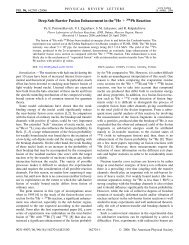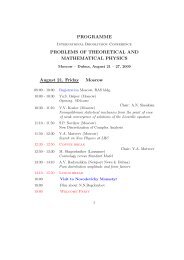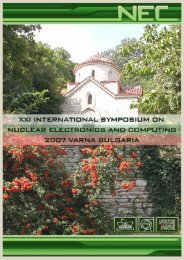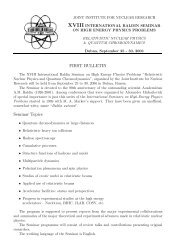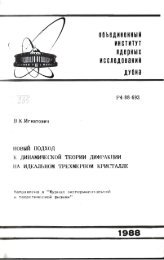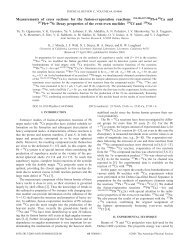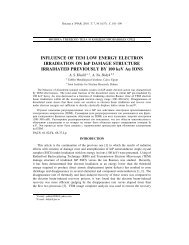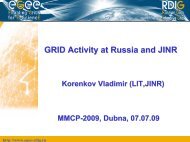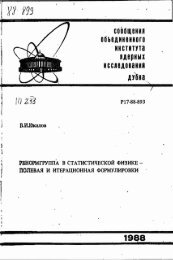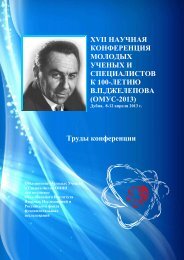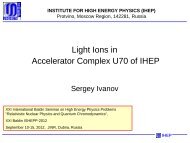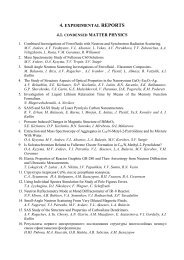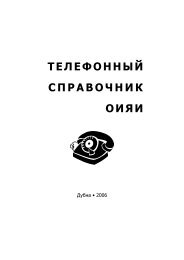Joint Institute for Nuclear Research Relativistic ... - Index of - JINR
Joint Institute for Nuclear Research Relativistic ... - Index of - JINR
Joint Institute for Nuclear Research Relativistic ... - Index of - JINR
Create successful ePaper yourself
Turn your PDF publications into a flip-book with our unique Google optimized e-Paper software.
A MODELING OF THE PION-NUCLEUS MICROSCOPIC OPTICAL POTENTIAL<br />
AT ENERGIES OF 33-RESONANCE AND IN-MEDIUM EFFECT ON THE PION-<br />
NUCLEON AMPLITUDE OF SCATTERING<br />
V.K. Lukyanov, E.V. Zemlyanaya, K.V. Lukyanov,<br />
E.I. Zhabitskaya, M.V. Zhabitsky<br />
<strong>Joint</strong> <strong>Institute</strong> <strong>for</strong> <strong>Nuclear</strong> <strong>Research</strong>, Dubna, Russia<br />
E-mail: vlukyanov@jinr.ru<br />
Analysis is per<strong>for</strong>med <strong>of</strong> differential cross sections <strong>of</strong> elastic scattering <strong>of</strong> pions on different<br />
nuclei at energies between 130 and 230 MeV. To this end the pion-nucleus microscopic<br />
optical potential (OP) [1] was constructed using the optical limit <strong>of</strong> a Glauber theory. Such an<br />
OP is defined by the corresponding target nucleus density distribution function and by the<br />
elementary N-amplitude <strong>of</strong> scattering. Then the pion-nucleus cross sections were calculated<br />
by numerical solving the corresponding relativistic wave equation [2] with the above OPs.<br />
The three parameters <strong>of</strong> the N scattering amplitude, total cross section, the ratio <strong>of</strong> real to<br />
imaginary part <strong>of</strong> the <strong>for</strong>ward N-amplitude, and the slope parameter, are firstly taken from<br />
existing experimental data on scattering <strong>of</strong> pions on free nucleons. As the next step these<br />
parameters were fitted to the data on the respective pion-nucleus cross sections [3],[4]. Thus,<br />
comparing the sets <strong>of</strong> “free” parameters to those obtained from pion-nuclear scattering data,<br />
one can estimate the “in-medium” effect on a pion surrounded by nuclear nucleons. The<br />
special procedure <strong>of</strong> the freely variation <strong>of</strong> parameters [5] was developed and applied to get<br />
the fast and effective 2 minimization process. A difference between the best fit values <strong>of</strong> the<br />
in-medium and free parameters <strong>of</strong> the N scattering amplitude is discussed. Conclusions on<br />
the mechanism <strong>of</strong> scattering at the 33-resonance energies are made.<br />
1. V.K. Lukyanov, E.V. Zemlyanaya, K.V. Lukyanov // <strong>JINR</strong> Preprint P4-2004-115, Dubna,<br />
2004; Phys. At. Nucl., 2006. V.69. No.2. P.240.<br />
2. V.K. Lukyanov, E.V. Zemlyanaya, K.V. Lukyanov, and K.M. Hanna // Phys. At.<br />
Nucl., 2010. V.73. No.8. P.1443.<br />
3. B.M. Preedom et.al. // Nuc.Phys. A, 1979. V.326. P.385-400.<br />
4. P.Gretillat et.al. // Nuc. Phys. A, 1981. V.364. P.270-284.<br />
5. E.I. Zhabitskaya, M.V. Zhabitsky // Springer Lecture Notes in Computer Science, 2012.<br />
V.7125. P.328-333.<br />
87



